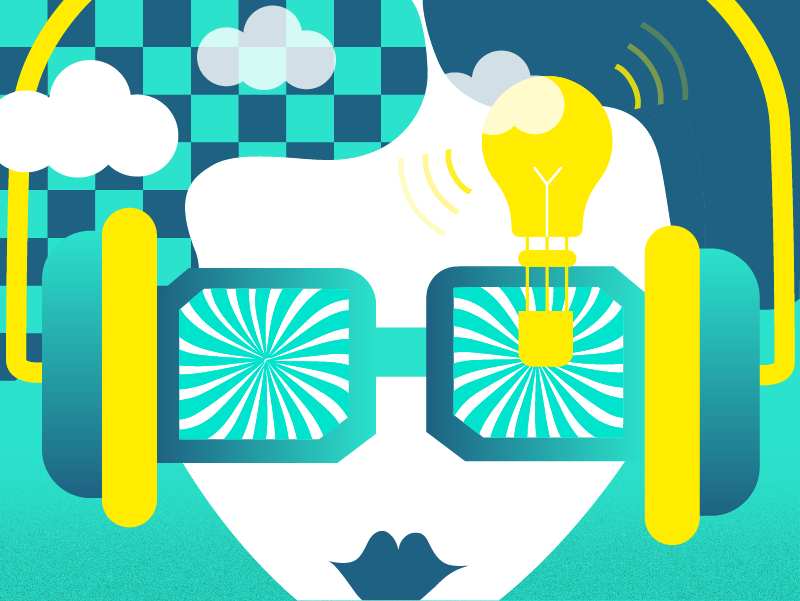
Dec 4, 2019 | Design, Digital Learning, Insight
We live in an age of rapid transformation. This means our current skillsets frequently get outdated. Learners of today are expected to continually learn and develop their skills.
Building a culture of continuous learning and development is at the forefront of a healthy corporate culture. This can be established by providing the learners with just-in-time learning opportunities.
Tailored everyday learning
Organizations are moving away from a one-size-fits-all approach to learning and development. This includes creating personalized learning paths to help employees in their current as well as their future roles.
Learning is expected to be an integral part of the everyday work. Technology can aid employees to learn at their own pace. An e-learning course can easily be carried out in pieces or repeated if needed. With the help of data and artificial intelligence we can tailor and recommend trainings just according to the needs of the individual.
With the abundance of open online learning content, the practice of content curation and validation becomes all the more valuable and helps to separate the wheat from the chaff.
Gamification
Game-based learning can both educate and engage the users. What is important to note here is that the games need to be well structured and keep the player engaged in the learning process. They need to be challenging, rewarding, time efficient and mobile.
At Intolead we have successfully implemented gamification into the learning solutions we have created together with our customers. One example is a new employee’s onboarding course that was created in a form of a game board. That way the information is well structured, and the learner proceeds the onboarding like playing a game by completing different tasks.
Social Learning
The majority of employees say that knowledge sharing with their team is critical for their learning. Peer-to-peer learning is increasingly gaining traction because it empowers people to share relevant content with their co-workers. Employees expect workplace technologies to enable social networking, online collaboration, video conferencing and instant messaging.
Micro learning
Micro learning enables an organization to implement learning in small sections (3-5 minutes) that are objective driven and are easy to utilize within organizations. Learners are also able to repeat the modules, so retention of information is better.
Micro learning can be implemented in various forms (videos, quizzes, podcasts etc.). Its biggest advantage is that it can be implemented on any device.
Mobile Learning
This is not a new trend, but message from our customers is clear: mobile is becoming the preferred option to view content. Mobile friendly curated content will enable employees to do their training courses anywhere, anytime. Mobile-optimized learning platforms will include access to the above-mentioned gamification and employee-curated information as well as social learning and peer-to-peer interactions, video’s, blogs and the rest.
What are your workplace’s needs?
No workplace is the same and the needs of employees and companies vary.
Although learning is becoming more self-driven there is still need for managers to help promote learning at the workplace by providing the resources needed. Ideally, the employee’s own developmental needs and interests are in line with the organization’s targets.
Good learning solutions are not just e-learning courses, but overall solutions for the organization’s competence development that support the strategy execution of the company. We at Intolead take into account the needs of learners and businesses and design the learning solutions accordingly.

Nov 1, 2019 | Business Strategy, Design, Insight, Strategy
Visual management utilises instinctive visual cues to convey accurate information in a succinct way. This enables management, employees and customers to receive key information at a glance.
Studies show that people remember as much as 80% of the things they see and do but only remember 10% of the things they hear and only 20% of the things they have read.
Visuality is the process of seeing or looking, but has a clear purpose, is more critical and direction oriented than merely seeing. It applies to our sensory perception and how information can be communicated quickly and effortlessly by using mainly our human sense of sight as well as our other senses. An easy to understand example of visuality and how visual perception relates to the immediate understanding of certain concepts is the white or yellow lines on a road.
Visual Management is about communication
Signs and other visual cues are put in place to help employees and customers make sense of the organisational context or business by merely looking around. Visual Management in the workplace gives structure to the space and enables the easy flow of work processes.
All it takes to understand certain operations is to look around. It is a management system that tries to improve the performance of an organisation or business. Visual Management does this by connecting and aligning the vision of the organisation, its core values, culture and goals with other work place related elements such as management systems and work processes by using human sensory experiences. These stimuli directly engage one or more of our five human senses: sight, sound, smell, taste and touch.
Benefits of Visual Management
Using Visual Management can entice staff to be more creative thinkers. Using Visual Management also means that the environment is constantly communicating with the employees and customers. This can lead to bottom-line improvements as well as improved safety in the organisation. Visual Management also helps with company-wide alignment and unity.
By displaying the current progress of projects for all to see, top management is able to receive progress information every time they look at the display. Not only does this indicate what the progress on each project is, it also indicates to staff what the next steps are as well as how to go about achieving the rest of the project objectives.
Secondly, using Visual Management encourages employee engagement by allowing ownership of goals and creating or increasing motivation among the employees. Visual Management is non confronting in its approach, but it does demand authority and represents the real time factual status of projects. It embeds a culture of continual development and improvement in every aspect of the company.
Thirdly, Visual Management can be used to convey transparency in an organisation. By having it out in the open, no information is hidden. This means that the goals and progress of the project is shared openly and they company is united in achieving these goals.
Visual Management might seem like a foreign concept to grasp, but the application thereof is without a doubt incredibly practical. Visual Management is an easily applied practical concept that could improve everything in a business, from the bottom-line through to overall company morale, overall company safety and transparency.
References:
Tezel, A., Koskela, L. J., Tzortzopoulos. (2009). The Functions of Visual Management. Conference Paper.

Sep 18, 2019 | Design, Future Skills, Insight, Strategy
Whether you’re an entrepreneur, executive, expert or an educator, we’re all increasingly being asked to make decisions about our impact – and the impact of the companies and organizations we work or interact with. More and more companies and organizations are talking about impact and aspiring to create it. Yet, our shared approaches to systematically collecting impact data and making decisions based on it – are still inadequate or confusing.
From accountability to impact
The term impact has often been defined to refer to significant or lasting changes in people’s lives, brought about by a given action or series of actions. Since the early 1990s, the requirement of accountability has been ascendant. A more recent manifestation of this discussion has centered on impact, or demonstrating evidence of how much difference you’re making.
Metrics & alignment
Harvard Business School professors Ainoor Ebrahim and V. Kasturi Rangan argue in their article that it is not feasible, or even desirable, for all organizations to develop metrics at all levels of a results chain, from immediate outputs to long-term societal impacts. Their claim is that the more important challenge is one of alignment: designing metrics and measurement systems to support the achievement of well-defined mission objectives. According to them, impact is better measured at the higher, systemic level, leaving the individual organizations to do what they do best — focus on their more specific missions.
Two types of impact
There are however two different types of impact that we need to take into account: Program-level impact is the impact that individual services have on the people who directly participate in them. Community-level impact is the impact that many different partners, working in collaboration, have on a specific population (community, town, state. etc.) Individuals and organizations can only be held responsible for the performance of the programs and services that they manage.
Impact for learning
When it comes to learning, it is important to try to grasp the impact of your efforts on a program-level. Let’s say you organize a series of coaching sessions aimed for all the managers in your company. The usual way to follow up on this kind of initiative is to focus on the numbers: i.e. how many of all the managers have participated the coaching. Now, this is all well and fine, but instead of settling for the reach in numbers, we should also be able to get an idea of what changes after the coaching. Did the managers adapt newly acquired skills to practise? Can the team members or colleagues tell the difference? It is precisely these kinds of questions we need to address in order to gain insights on the depth of impact for our learning efforts.
Impact tools & frameworks
While this may sound like an overly complicated a task, there are tools and frameworks that can help you better understand and accomplish this.
With the help of technology we can collect data from end users more efficiently. We can then extract insights in ways that allow us to better serve our customers and achieve more impact.
Another possibility that can help in our impact efforts is systems practice. It is an approach that can help to gain clarity about your environment as a dynamic system. It also provides an approach to effectively learn and adapt your understanding of your system and the impact your trying to achieve.
Impact analysis frameworks have also evolved from assessment of immediate results to measuring longer term outcomes and impacts. While these include various different philosophies and approaches from expected return methods to theory of change and lean data, they are not mutually exclusive. In many cases it is good idea to figure out which approaches are most suitable to your project and then combine several of them accordingly.
Ultimately learning about impact is grounded in a simple activity: listening to open and unbiased feedback from our customers and end users. Rather than a separate project, impact is something to be continuously pursued. It is also a key to finding sustainable solutions and designing growth – be that on a business, community or individual level.

Nov 30, 2017 | Design
Data and information are quickly becoming abundant, and often more disruptive than forward taking. Information overload prevents us from taking decisions or actions because we feel we have too much information to absorb and apply. That’s why need for insight and foresight are rapidly increasing.
INSIGHT VS. FORESIGHT
Both insight and foresight are needed in order a business successfully build a future.
Insight is the capacity to gain an accurate and deep understanding of someone or something happening now. Insight is something that answers question WHY? What matters now and why?
Foresight is the ability to accurately predict outcomes of proposed decisions and actions. What WILL happen or what will be needed in the future? What matters next?
FORESIGHT VS. TREND
Foresight sometimes gets confused with trend. Whereas foresight is an ability to predict, trend is a general direction in which something is developing or changing. Foresight is more about intuition, imagination, creativity, and out-of-the-box-thinking with ability to detect weak signals.
INSIGHT VS. HINDSIGHT
In practice, insight often gets confused with hindsight: understanding of a situation or event only after it has happened or developed. Despite bad reputation, hindsight often plays a valuable role in learning. What lessons can be learned?
ROLE OF AI ON ALL SIGHTS
Artificial Intelligence will have an impact on all levels of understanding. Instead of fearing the inevitable, for whatever reason, we can focus on opportunities.
Human value on data and information has already nearly vanished. It’s rapidly vanishing on insight and hindsight. Some of us are hoping it will not vanish on foresight and see AI as something that will allow us to focus on those added value parts: understanding, deciding, creating, imagining, and acting.
Foresight will be there to challenge existing norms, truths, mindsets and roles. To take us as individuals and businesses forward.




